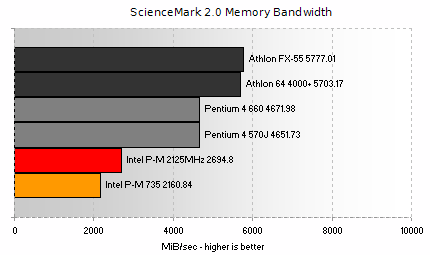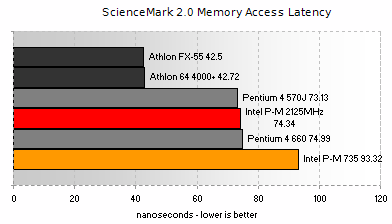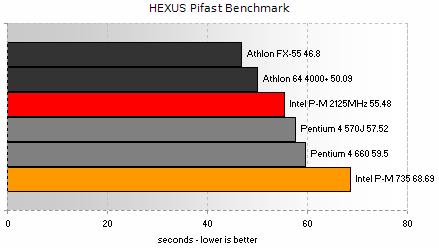Memory Benchmarks
Before I present the numbers, there's a couple of things to keep in mind when thinking about current Pentium-M performance using 855GME. The first is the single channel of DDR333 memory that the processor has to work with. Compared to the dual channels of DDR400 that most modern systems enjoy, the Pentium-M has that to battle with.Secondly, the length and ability (mostly the point during execution with which it addresses memory) of a CPU's main pipeline can affect memory performance, regardless of the memory subsystem it's connected to. That's why you'll see Prescott-1M and Prescott-2M be able to extract more buffered memory bandwidth from current P4 corelogic than Northwood or Gallatin-2M can.
So keep those things in mind as we first examine the memory performance of Pentium-M, paired with 855GME.
ScienceMark 2.0 - Memory Bandwidth

What I outlined above is manifest in the buffered bandwidth figures. Around 80% efficiency is great for an off-CPU memory controller, but when all that's connected is a single channel of DDR333 memory the bandwidth available isn't great. While the architecture of Pentium-M may not require masses of memory bandwidth for good performance, it can never hurt to at least match that which the CPU is able to make use of on its own bus. For Pentium-M, on a 64-bit wide bus at 400MHz, that's some 3.2GB/sec (a single channel of DDR400 memory).
Bandwidth scales nearly exactly with the 25% increase in memory clock, as expected.
ScienceMark 2.0 - Access Latency

In terms of accessing main memory, current Pentium-M on its slow front side bus, does great. It only takes a boost to 125MHz for it to match current Pentium 4 in that respect, so you can imagine what future Pentium-M processors on 200MHz (800MHz effective, like the Pentium 4) will be like in that respect, if paired to good memory controllers. Access latency should be halved, in effect.
HEXUS Pifast

The memory subsystem performance is shown in Pifast and you can see it responding to the differences. Clock frequency plays a part, too.









